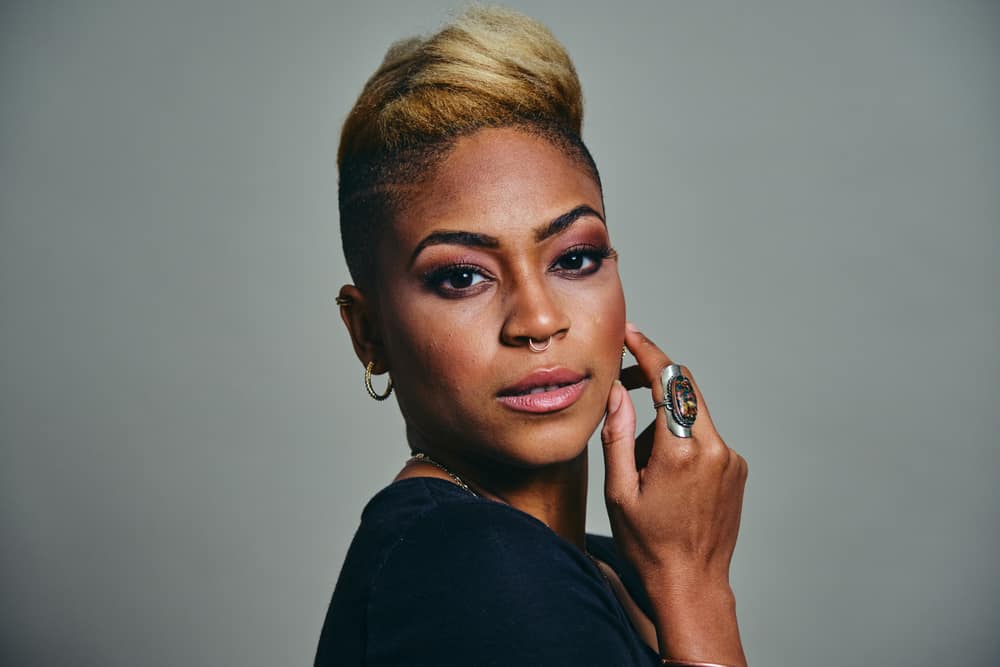
Whether you accidentally bought the wrong developer strength or found a bottle of 40-volume hanging out under the sink, we’ll bet you want to get some use out of it.
Thankfully, you can still use that 40-volume developer if you dilute it to a lower strength – for example, 20-volume. And that’s what we’ll be covering in this article.
By the end, you’ll know precisely how to dilute 40-volume developer to 20.
Table of Contents
How to Dilute 40-Volume Developer to 20
Diluting a 40-volume developer to 20 is more straightforward than you may think. It doesn’t require a complicated math equation or a ton of hair products. Here’s how it works.
When diluting 40-volume developer to 20, you’re essentially cutting the 40-volume developer to roughly half its strength. Use a 1:1 mixing ratio for the desired results.
Note: You can use this same mixing ratio to dilute different volumes. For example, you can dilute 30 volume developer to 10 or an even lower-volume developer.
Instructions for Diluting 40-Volume Developer to 20-Volume
Follow the below instructions for easy and accurate dilution:
- Dispense the 40-volume developer into a measuring cup to get started. Take note of how much of the developer you poured into the measuring cup.
- Pour the developer into a mixing bowl.
- Use your measuring cup to measure out the same amount of water. For instance, if you measured out 5 ounces of developer in step 1, that’s how much water you’ll measure out.
- Pour the water into the mixing bowl with the 40-volume developer.
- Mix the developer and water with a dye stirrer until you’ve got an even consistency.
- Your new 20-volume developer is ready for use!
Key Takeaways
- Dilute Hair Developer Method. Easily dilute 40 vol developer to 20 by using a 1:1 ratio of developer to water. This approach allows you to adjust the strength without buying different developer strengths.
- Importance of Accurate Measurement. Use a measuring cup to ensure you use equal parts of developer and water (e.g., 5 ml of developer to 5 ml of water). This process prevents undesirable results in the dyeing process due to strength imbalances.
- Mixing for Consistency. Thoroughly mix the developer and water with an applicator brush or dye stirrer. This technique will ensure a uniform mixture that affects the hair shaft evenly.
- Water Type Consideration. Tap or distilled water can be used. Distilled water is recommended for areas with hard water or high pH levels. Hard water affects the effectiveness of hydrogen peroxide in the developer.
- Developer Strength for Different Hair Types. Choose the strength of the developer based on your hair type and desired outcome. For example, use 20-volume for up to 3 levels of lift and 30-volume for more significant changes. Semi-permanent hair dye might require different developers.
Keep reading for more information on how to dilute developer step-by-step.

Mistakes People Make When Diluting Developer
To help you prevent problems as you dilute the developer, let’s get into some of the most common mistakes people make throughout the process.
Not Using a Measuring Cup to Mix Developer
You may be tempted to eyeball the developer and water, but we advise against that. Your eyes can be deceiving, and you don’t want to end up with a more potent (or weaker) developer than you were trying to create.
If you add too much water, your developer will be too weak and may be ineffective.
If you add too little water, your developer strength will be higher than 20-volume. Precision is essential when diluting developer, so you’ll need a measuring cup.
Not Mixing the Developer/Water Mixture Thoroughly
Mixing your developer is just as crucial as getting the measurements right. If you undermix it when you apply it to your hair, those undermixed portions will remain at the higher developer level (40).
This increases your chances of damage during the coloring or bleaching process.
To ensure that your developer is adequately mixed, you can use a whisk or dye stirrer. You may find that you need to mix for a minute or two. Once you’ve got a smooth, uniform mixture, you can rest assured that you’ve mixed it enough.
Does the Type of Water Matter When You Dilute Developer?
After learning the basics of developer dilution, one of the first questions people have is, “What type of water should I use?” That’s a very valid question, given that some online hair dye outlets mention using distilled water for this purpose.
The truth is that people have used both tap water and distilled water to dilute their developer. In most cases, you can use whichever one you have on hand.
But the only time you would need to use distilled water is if you have extremely hard water or if the pH of your water is unusually high.
So, feel free to use tap water if that’s all you have access to.

Which Developer Strength Is Best to Lighten Hair?
Now, let’s get into another topic you should consider. Is a 20-volume developer the right choice for you? It’s easy to get confused by the many developer strengths available.
So, we’ll cover the instances when 20-volume is appropriate and when it isn’t.
When to Use 20-Volume Developer
20-volume developer is the most popular developer strength, and it’s often used in box dyes. It’s commonly used to lighten natural hair and deposit a new hue simultaneously.
But you can also use it with bleach to lighten the hair without depositing a new color over it. When used with bleach, 20-volume developer can lift your hair up to 9 levels in just one session. But when you use it with professional hair dye, you can expect up to 3 levels of lift.
20-volume developer also covers gray hair like a dream.
If this is what you’re looking for in your next dye job, 20-volume is likely the right choice for you.
When Not to Use 20-Volume Developer
20-volume is not going to be sufficient if you want 4 or more levels of lift at once. Going from very dark hair to a platinum blonde with a 20-volume developer is not recommended.
A higher volume developer (at least a 30) will be needed to give you the lift you need.
Lastly, if you’re going darker than your natural hair color, using a 20-volume developer is a mistake. For dyeing situations like this, you’ll need a 10-volume developer, which is the standard for no-lift permanent hair color.

Can You Dilute Developer with Conditioner?
If you’ve done prior research on this topic, you may have come across some claims that you can dilute developer with conditioner. If you do mix your developer with conditioner, the following things may happen:
- The developer’s effectiveness may plummet randomly to the point where you don’t know what strength it is. Since every conditioner is formulated a bit differently, it’s near impossible to determine the water content of a given one. That’s why experts go with distilled or tap water for developer dilution.
- If you use a conditioner-diluted developer, your color results may be uneven. The longevity of your color may also be shortened due to inadequate dye penetration.
Is It Necessary to Dilute Developer?
Though diluting 40-volume developer is not complicated by any stretch of the imagination, it does take extra time. This may prompt some to wonder whether dilution is even necessary.
Here are a few reasons why it’s a non-negotiable step:
- You have compromised hair. If your hair is already compromised (dry, brittle, breaking, etc.), dyeing it with a 40-volume developer is akin to burning it off entirely. In this case, you definitely need to dilute your 40-volume developer.
- You are going for a subtle color change. Subtle color changes and 40-volume developer don’t mix. You should only use 40-volume developer at its full strength if you’re going for a dramatic transformation that requires at least 4 levels of lift.
- You are not a trained professional. Unless you’re a trained colorist, we advise you to take the extra steps to dilute your 40-volume developer to 20. It’s way too easy to ruin your tresses with 40-volume developer. The chances of adverse consequences rise considerably if you leave 40-volume developer on a couple of minutes too long, mix developer incorrectly, or accidentally apply it to bleached sections of your hair. If you go to a trained professional for a color job requiring 40-volume developer, you’ll likely be in capable hands.

Frequently Asked Questions
Do you have questions about diluting 40-volume developer to 20? Our FAQ section has clear answers to help you get the best results with your hair care routine.
Can You Dilute 40 Developer With 20?
Diluting a 40-volume developer with a 20-volume developer is an effective way to create a custom developer strength. By combining the two, you can achieve a middle ground between the lifting power of the 40-volume developer and the gentler action of the 20-volume developer. Always mix in a non-metallic container and apply according to your hair dye's instructions.
How Do I Make a 20-volume Developer?
Making a 20-volume developer from a 40-volume developer is achievable by diluting the higher-volume developer with water. Combine equal parts of the 40-volume developer and water in a non-metallic container to create a 20-volume developer. The resulting mixture will be suitable for use in various hair color processes.
How Do You Dilute 40 Vol Peroxide?
To dilute 40-volume peroxide, you can use water as a diluting agent. Combine equal parts of the 40-volume peroxide and water in a non-metallic bowl or container. Mixing the solution thoroughly will result in a 20-volume peroxide that can be used for various hair coloring applications.

How Do You Dilute 40 Volume to 10 Volume?
Diluting a 40-volume developer to a 10-volume developer can be done by mixing the 40-volume developer with three parts water. In a non-metallic container, combine one part 40-volume developer with three parts water. Stir the mixture thoroughly, and you will have a 10-volume developer ready for use.
How to Dilute 40 Volume Developer to 30 With 20
To dilute a 40-volume developer to a 30-volume developer using a 20-volume developer, mix two parts of the 40-volume developer with one part of the 20-volume developer. Combine the hair developers in a non-metallic container and mix well. The resulting solution will be a 30-volume developer suitable for a variety of hair coloring processes.
How to Dilute 40 Volume Developer to 20 With Water
Diluting a 40-volume developer to a 20-volume developer using water can be done by mixing equal parts of the developer and water. In a non-metallic bowl, combine one part 40-volume developer with one part water. Mix the solution well, and you will have created a 20-volume developer suitable for various hair coloring applications.
- 30 Volume Developer on Black Hair
- Volumizing Powder for Hair
- How Long to Leave Bleach on Hair 20 Vol
- Does Developer Lighten Hair?
There you have it - diluting your 40-volume developer to 20 takes nothing more than mixing developer with water using a 1:1 ratio.
If you’re up for about 5 minutes of measuring and mixing, you can make your own 20-volume developer, which works just as well as the kind you’d pick up from the beauty supply store.
We hope that this article has been helpful to you, having given you all the information you need to dilute developer like the pros. Good luck with your next hair color transformation!




